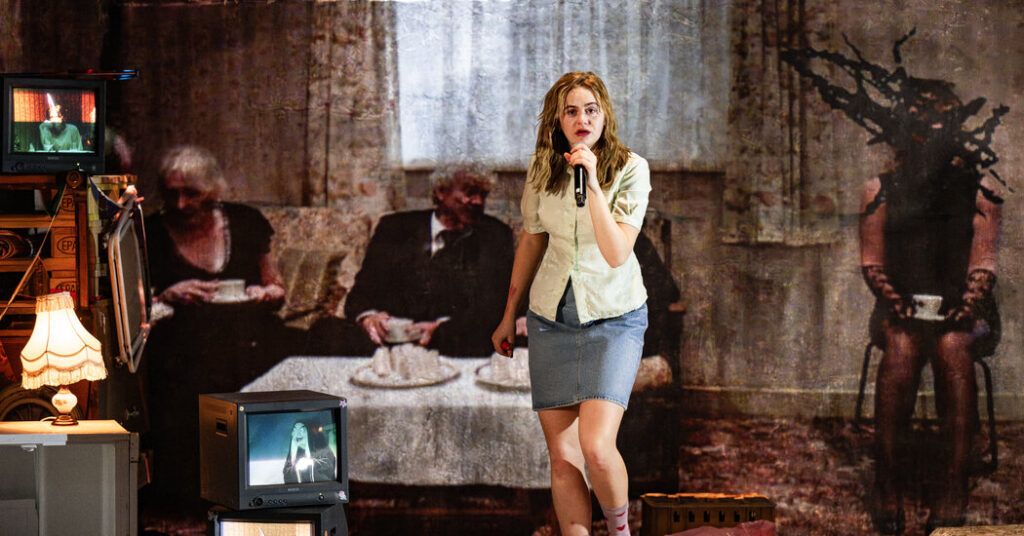Wearing a meadow-green T-shirt that proclaims her an Irish Princess, Grace dances with a white stuffed bunny that is her confidant. The music is Tchaikovsky’s “Sleeping Beauty” waltz, and it’s a clue to how Grace’s life plays out — not the ballet’s storybook ending, just the tragic parts.
In this snippet of a scene near the top of Enda Walsh’s new play “Safe House,” which opened on Thursday at St. Ann’s Warehouse in Brooklyn, the music gets speedier, more intense, all sense of comfort vanishing. Control, too, but that’s hardly a constant for Grace, a homeless young woman with a mind blurred by alcohol. Like Sleeping Beauty after the curse kicks in, she is exiled from a life that looked secure enough from the outside but was treacherous from the start.
Fair warning, though: Woven through with songs by Anna Mullarkey that are sung by Kate Gilmore as Grace, Walsh’s Abbey Theater production feels more like a live performance of a concept album than a play. In his plumbing of trauma and abuse — think “The Walworth Farce” or “Medicine,” his most recent play at St. Ann’s — he can have a way of reaching right into your viscera. Not here, unfortunately.
In “Safe House,” it is 1996 in rural Galway, and Grace is scrabbling together an existence on the margins. Guzzling box wine, trading her body for money, she plays grim bits of her sepia past on repeat in her head; for us, these are projections upstage or scraps of audio. Long gone though she is from the home she grew up in, which for her was a place of harm, she has not severed every family tie.
On the other end of a phone, we hear her father pick up.
“I can hear you breathing,” he says, in Irish. “Where are you, Grace?”
Telling her story in loops of bruised memories and shards of implication, the show is precisely framed and layered, pleasing to the eye and ear: video and voice-over, confetti and fog. The music sounds like loneliness and hope. There’s a hint of ’90s indie pop, too, with shades of Dolores O’Riordan — or maybe it’s just defiance — in Gilmore’s voice. (Set and costume design are by Katie Davenport, lighting by Adam Silverman, video by Jack Phelan, sound by Helen Atkinson.)
But the whole of “Safe House” feels distant, and that isn’t Gilmore’s doing. There’s no losing ourselves in the play, no entering Grace’s story, because she isn’t even a symbol, really, but rather an abstraction: a girl who grew up on princess myths and notions of female grace, who dreamed of a kinder, more love-filled life, who still seeks a place of safety.
We’re in her head, sort of, but minus all the context she has for these daggers of recollection. In video, we see young Grace in a Cinderella dress and tiara, and we hear her aunt call her “the princess.” We gather that Grace’s mother beat her — a cruelty akin to the witch’s in the “Snow White” clip we glimpse on little box TVs. We watch grown-up Grace enact a deathlike Sleeping Beauty tableau that probably should make us shiver, yet is pleasing aesthetically.
Walsh, a prolifically, experimentally form-shifting creator, writes in a program note of the play’s deliberate obliqueness. Certainly that can be a vital element in a work of art, accommodating even opposing interpretations. But there is such a thing as being too oblique.
This isn’t the customary disorientation of a Walsh play, where you’re thrust into a strange universe that asks you to puzzle it out. “Medicine” was like that: chaotic and messy, loquacious and unhinged, but with a pulsing sense of the lost human being at its center. “Safe House,” which would seem in form and subject matter a natural successor, is far neater, but so verbally pared back that it gives the audience too little to hold onto.
It’s frustrating, because so many ingredients of a deeper experience are in place, yet sans the alchemy. The penultimate stage image, which I won’t spoil, is breathtakingly theatrical. It would leave us shattered if “Safe House” worked as I think it means to. I was unscathed.
I did wonder if the world’s current turmoil had colored my receptiveness. But I wanted this play to consume me. I wanted the shattering.
Maybe next time.
Safe House
Through March 2 at St. Ann’s Warehouse, Brooklyn; stannswarehouse.org. Running time: 1 hour 30 minutes.


